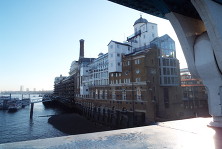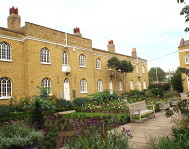








Deal Porters
The import of timber and deal (an easy to saw softwood that comes from coniferous trees such as pine and spruce) was the mainstay of the Surrey Commercial Docks. The imported timber was not just to meet the high demand in nineteenth century London caused by the boom in house building but also for onward shipping to other parts of the world. Ponds were specially built for storing the cut planks and yards set aside where towering piles of timber reaching 30 - 60 ft high were stacked. In a time when carrying and moving goods was not done by machine, the job of deal porter emerged as a highly skilled and dangerous form of manual labour.
Originally, timber was transported in ships still in the form of large logs, but in the 1820s it was realised that more timber could be fitted onto a ship if the logs were cut into planks in the country of origin before loading. The job of sorting, carrying the timber and storing it when it arrived in the Surrey docks was the job of the deal porter. It was a job that required great strength, as the heavy planks were carried on one of the porter’s shoulders. He wore a specially adapted hood for protection, and a sure step and agility were also needed for as the stacks of timber got higher, the porters reached the top by walking up one of the planks that had been placed at an angle or from the top of another nearby stack. The deal porters were the elite of the manual trades in the docks but it was a job for fit young men only, by the age of 40 the porters were considered too old to continue.
The New Survey of London Life and Labour of 1928 described the work of the deal porter first hand:
"Deal portering is heavy and dangerous work which cannot safely be undertaken by any save experienced men. The shoulder of an experienced deal porter is said to develop a callosity [hardness] which enables it to bear the weight and friction of a load of planks. But even with a hardened shoulder the deal porter has an unenviable task. To carry over a shaking, slippery plankway a bundle of shaking slippery planks, when a fall would almost certainly mean serious injury, is work for specialists."
One of the last jobs to be mechanised in the Surrey Docks, deal porters were still being trained in 1965. A sculpture by Philip Bews was installed at Canada Water in 1995 to remember the deal porters and a skill that has become obsolete. It depicts a “strapper”, the porter who carries the wood and the “holder up” who assists the strapper in loading and balancing. A nearby road is called Deal Porter’s Way and the new public square by the side of the new library is named Deal Porter Plaza.
The Deal Porters by Philip Bews at Canada Water.
Web discoveries
- UK Casino Not On Gamstop
- UK Casino Not On Gamstop
- Non Gamstop Casino
- Casinos Not On Gamstop
- Non Gamstop Casinos
- Non Gamstop Casinos
- Non Gamstop Casino
- Casinos Not On Gamstop
- Casino Sites Not On Gamstop
- Slots Not On Gamstop
- Casinos Not On Gamstop
- UK Betting Sites Not On Gamstop
- UK Casino Not On Gamstop
- Best Non Gamstop Casinos
- Betting Sites
- Non Gamstop Casino Sites UK
- Best Non Gamstop Casinos
- Non Gamstop Casino
- Casinos Not On Gamstop
- Non Gamstop Casino Sites UK
- Horse Racing Betting